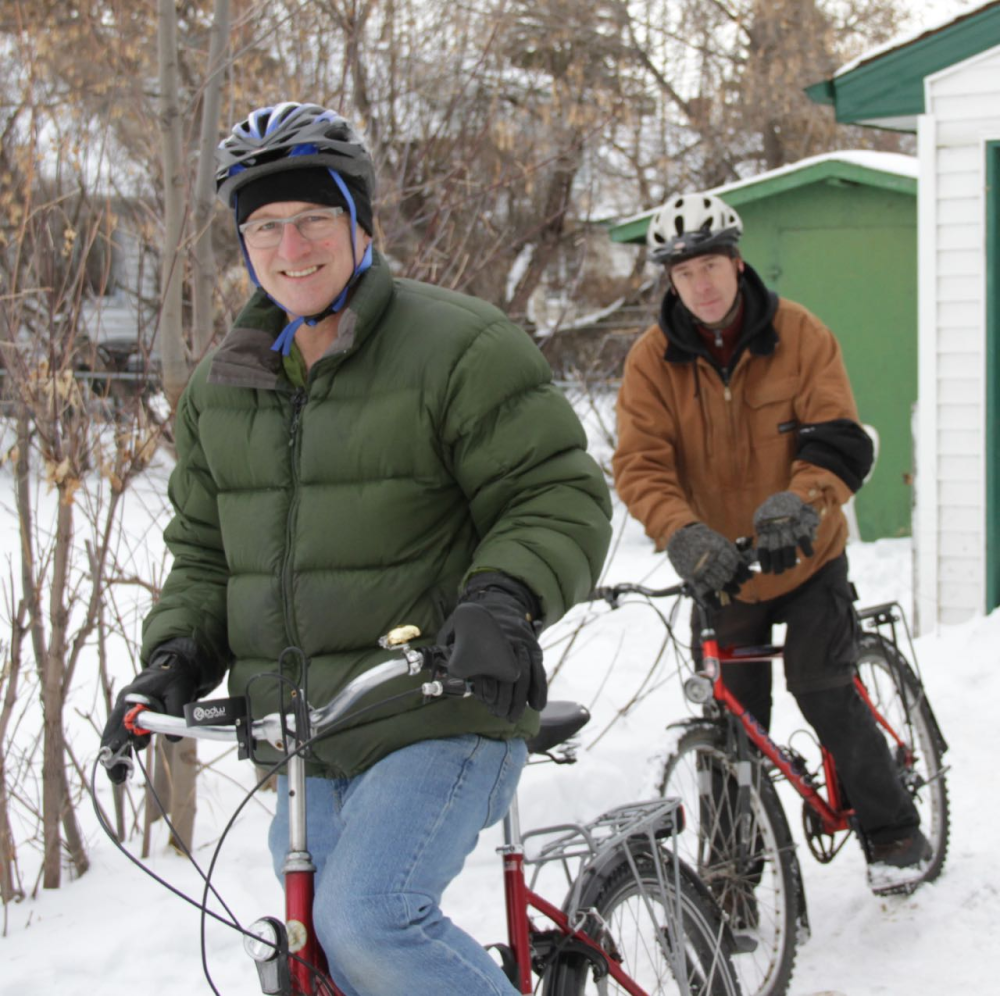What would it take to get you out of your car and on to your bike for your work commute in the winter?
We’ve learned that good bike infrastructure can certainly help alleviate congestion in cities like Vancouver and that electric bikes are a sexy new option for longer commutes.
But I distinctly remember bailing pretty hard on the ice as a young winter cyclist. And it’s that fear of awkward falls, cold winter winds and icy hands that keep many of us from trying this super energy efficient, healthy way of getting around in the winter.
Our past episode on Vancouver’s bike infrastructure is great if you want to know what cities can do to make cyclists feel safe but Vancouver is not exactly your typical Canadian winter city. So we set out to learn more about winter cycling from the people who do it and the decision makers who are trying to encourage it. And I even jump on a bike myself in an Edmonton winter.
Winter cycling gear
Keith Hallgren of RBF Cycles is a longtime four-season cyclist. He builds and fixes bikes, teaches courses on winter cycling and, full disclosure, he also built the winter bike of Green Energy Futures editor Duncan Kinney.
According to Hallgren there are three keys to being a successful winter cyclist:
- Studded tires – The single most important winter equalizer
- Good fenders – Keeps winter sludge off your drive train and clothes
- Lots of lighting – Long winter nights mean you need to be visible
And he’s right, my first venture onto Edmonton’s snow-covered streets was actually quite fun on a bike with studded tires. And I was kept dry on what was a pretty sloppy day with full fenders.
Hallgren also finds that the type of bike isn’t super important, you just need to be comfortable riding it. However mountain bikes tend to be the most popular winter bike choice.
Winter cycling clothing
 Keeping warm is probably the biggest concern that comes up.
Keeping warm is probably the biggest concern that comes up.
“In teaching a lot of winter cycling classes I tell people that if you do anything in the winter here you probably have most of the gear that you need,” says Hallgren.
Most everyone in Canada has a toque. You can use a scarf to keep your face warm, but Hallgren prefers a neoprene bank robber style mask. Just make sure to take it off before you head inside your favourite local business.
A moisture-wicking base layer is needed, so if you don’t have any long underwear get a pair. Hallgren recommends a merino wool sweater as a middle layer. And of course make sure you have a nice, warm jacket.
Hands are kept warm by layering gloves and mittens. Solid winter boots with wool socks are important as well. For your legs Hallgren recommends something a little more heavy duty than typical denim; he prefers a cotton duck pant.
I showed up for my first winter ride wearing a large down fill jacket and found I was much too warm.
“I have had people pull up next to me in giant pickup trucks in the winter and roll down their windows and tell me how awesome it is that I’m riding my bike in the winter. I’m thinking I’m not cold, I’m happy, I’m not stuck in traffic, I’m getting exercise there is not too much that is hard about it. 98 per cent of the time winter cycling is not burdensome to be doing,” says Hallgren.
A four season cycling politician
 While Edmonton isn’t at the level of winter bike meccas Montreal and Minneapolis, Edmonton city councillor Ben Henderson is working to get it there. He became a four-season cyclist because it was the fastest way to get from his house to city hall. Henderson has also been leading the creation of a Winter City Strategy. It’s garnered national attention and its goal is to get people to embrace winter and winter activities — like winter cyling.
While Edmonton isn’t at the level of winter bike meccas Montreal and Minneapolis, Edmonton city councillor Ben Henderson is working to get it there. He became a four-season cyclist because it was the fastest way to get from his house to city hall. Henderson has also been leading the creation of a Winter City Strategy. It’s garnered national attention and its goal is to get people to embrace winter and winter activities — like winter cyling.
“We are a winter city and we spent a lot of time in the last couple of decades trying to pretend we weren't, or trying to make winter go away or trying to hide from it, and all it was doing was making us miserable,” says Henderson.
Henderson has also consistently worked to get better, safer infrastructure for cyclists and for consistent snow clearing in the winter of bike lanes.
“That really is the only impediment to biking in the winter here, is just, whether or not we can keep the lanes clear enough for the bikes to ride safely.”
And there is a real, practical, city-building reason to get more people on bikes no matter what the season. Congestion costs everybody money.
“You can't widen roads enough to ever deal with the kind of demand. So, bicycles are one of the solutions,” says Henderson.
Winter cycling is only going to get more and more popular. Fatbikes are becoming more and more common. Writer Tom Babin has explored the world of winter cycling with his book Frostbike, a book we recommend. There is a Winter Cycling Congress coming up in Winnipeg. And Henderson has even convinced his fellow Edmonton city councillor Andrew Knack to take up winter cycling.
I am no diehard winter cyclist, but after our winter cycling 101 session with Keith Hallgren I learned that studded tires and some simple layers of clothing are all you need to enjoy winter on a bike.


